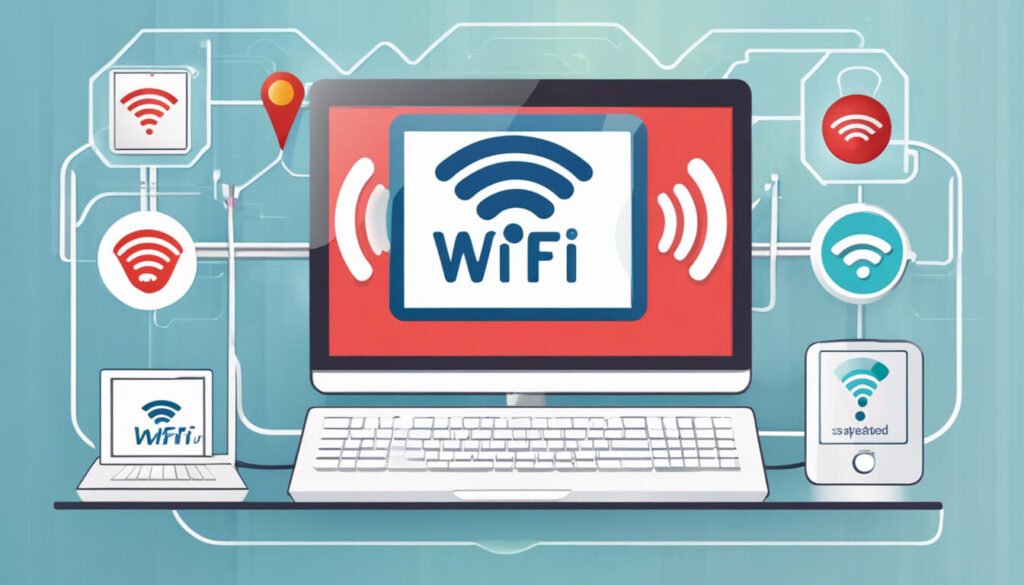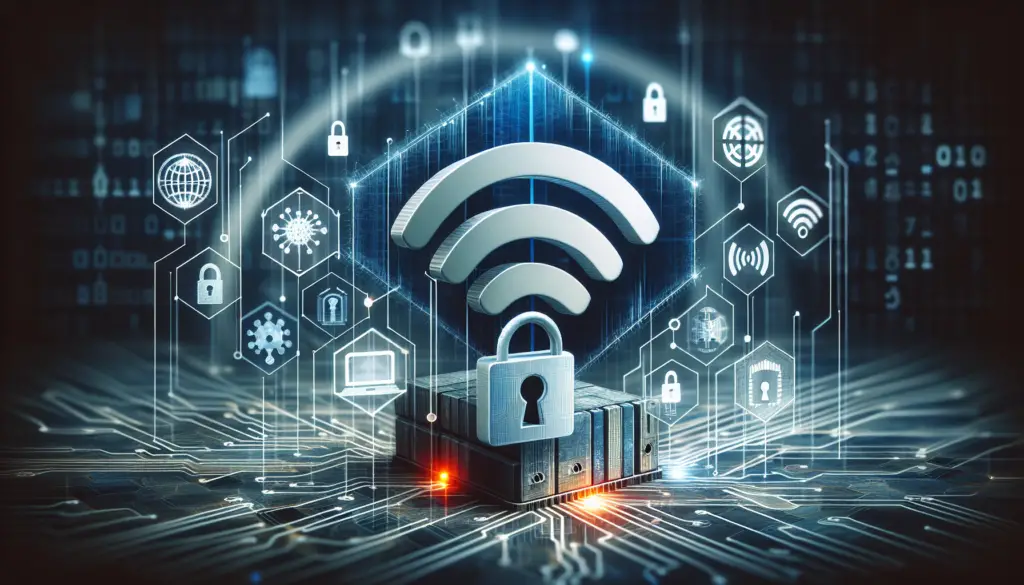Imagine you’re sipping coffee in a cozy corner of your favorite cafe, your laptop open as you casually browse the web.
Suddenly, the thought strikes you: How secure is your connection?
Every day, countless individuals and businesses rely on the magic of Wi-Fi to stay connected, yet the unseen threats lurking in cyber shadows never rest.
“Wi-Fi Network Security” is your indispensable guide to fortifying your wireless network, ensuring that your private information and digital life remain under lock and key.
From mastering the art of strong passwords to implementing robust security measures for expansive networks, this article empowers you with the knowledge to safeguard your online activities against the prying eyes of unwelcome digital intruders.
Understanding Wi-Fi Security
The Basics of Wi-Fi Networking
When you connect to a Wi-Fi network, your device communicates wirelessly with a router or access point.
These signals allow you to browse the internet, check your emails, and stream videos without being tethered to a cable.
But it’s essential to remember that anyone within range might also be able to intercept or join your network if it’s not properly secured.
Types of Wi-Fi Security Protocols
There are several security protocols that Wi-Fi networks can use to protect data as it travels through the air.
The most common ones you’ll encounter are WEP (Wired Equivalent Privacy), WPA (Wi-Fi Protected Access), WPA2, and the newest, WPA3.
Over time, wifi security systems have evolved to become more secure, with WPA3 being the latest and most secure option currently available.
Risks and Vulnerabilities in Wi-Fi Networks
Your Wi-Fi network faces various risks and vulnerabilities.
Without adequate protection, attackers can exploit weaknesses to intercept data, launch attacks on connected devices, or even use your network for illegal activities.
Common vulnerabilities include weak encryption, unpatched hardware, and the use of outdated security protocols.
Securing Your Wi-Fi Network
Changing Default Router Settings
One of the first steps in securing your network is to change the default settings on your router.
This means updating the default login and password, which are often easily guessable.
By customizing these settings, you make it significantly harder for someone to gain unauthorized access to your router’s configurations.
Creating a Strong SSID and Password
The name of your Wi-Fi network, known as the SSID, and the password are crucial elements of network security.
Create a unique SSID that doesn’t give away personal information and choose a complex, long password that’s a mix of letters, numbers, and symbols.
Doing so will help protect against brute force attacks and unauthorized network access.
Enabling Network Encryption
Encrypting your network is like putting your data in a safe; it scrambles the information so that it’s unreadable to outsiders.
Always enable the highest level of encryption available on your router—ideally, WPA3.
If your router only supports WPA2, it’s still fairly secure, but you might want to consider upgrading to a newer router for better protection.

Advanced Wi-Fi Security Features
Using Network Firewalls
A network firewall acts as a barrier between your Wi-Fi network and the internet, scrutinizing incoming and outgoing data for potential threats.
Many routers come with a built-in firewall, but you’ll need to ensure it’s turned on and configured correctly to provide effective protection.
Setting up a Secure VPN
A Virtual Private Network (VPN) provides an additional layer of security when you’re online, especially on public Wi-Fi networks.
It encrypts all data sent from your device, making it much harder for anyone to spy on your online activity.
Consider setting up a VPN for your home network for increased privacy.
Implementing MAC Address Filtering
Every device that can connect to Wi-Fi has a unique MAC address.
MAC address filtering allows you to create a list of devices that are allowed to connect to your network, adding another hurdle for unwanted visitors.
Just keep in mind that MAC addresses can be spoofed, so don’t rely on this feature alone.
Wireless Network Monitoring
Regularly Monitoring Network Traffic
It’s essential to keep an eye on who’s using your Wi-Fi and what they’re doing.
Regularly monitoring network traffic can alert you to unusual activity that could indicate a security breach.
Many routers offer logs and tools that allow you to review the data passing through your network.
Identifying Unauthorized Access
Stay vigilant for signs of unauthorized access, such as unknown devices connecting to your network or strange usage patterns.
Immediate action is crucial to securing your network, so be sure to have a plan in place for when you detect these red flags.
Using Network Monitoring Tools
There are various tools available that can help with network monitoring.
These can range from basic utilities that check for connected devices to more advanced software that provides in-depth analysis of network activity.
Such tools are invaluable for maintaining a secure Wi-Fi network.
Physical Security Measures
Secure Physical Access to Routers and Network Devices
Physical security is as important as digital.
Keep your router and network devices in a secure location where unauthorized individuals can’t easily access them.
This ensures that no one can reset your router to its default settings or connect to it directly without permission.
Dealing with Rogue Access Points
Rogue access points are unauthorized Wi-Fi routers that can create security risks.
They might be set up by malicious actors or well-meaning employees trying to enhance network coverage.
Either way, locate and remove any rogue access points to safeguard your network’s integrity.
Ensuring Device Security
The security of devices that connect to your Wi-Fi network can affect the network itself.
Ensure that all devices have updated software, security patches, and proper endpoint protection like antivirus software.
This creates a comprehensive security posture that defends against multiple angles of attack.
Educating Users on Wi-Fi Security
Promoting Security Best Practices
Encourage anyone using your Wi-Fi network to follow best practices like using strong, unique passwords for their devices and services, and being cautious about the information they share online.
This collective effort helps to strengthen the overall security of the network.
Training on Recognizing Phishing Attempts
Phishing attacks can compromise Wi-Fi security by tricking users into handing over sensitive information or installing malware.
Offer training on how to recognize and handle phishing attempts, which often come in the form of deceptive emails or messages.
Updating Users on Latest Security Threats
Stay informed about the latest security threats and pass that knowledge on to all users of your Wi-Fi network.
Awareness is a powerful tool in preventing security incidents before they occur.

Managing Network Access Control
Implementing Role-Based Access Controls
In a more complex Wi-Fi setup, like a business environment, implement role-based access controls.
This means designating different levels of network permissions based on a user’s role within the organization to minimize the risk of sensitive information being accessed by unauthorized users.
Creating a Guest Networking Policy
Setting up a separate network for guests keeps your main network more secure.
This means visitors can access the internet without posing a risk to your primary network’s security.
Ensure the guest policy includes measures like time-limited access and strong encryption.
Regularly Updating Access Credentials
Regularly changing your Wi-Fi network’s access credentials makes it harder for unwanted users to hang on.
Update passwords and other access information periodically, and especially after any personnel changes.
Dealing with Wi-Fi Security Threats
Types of Wi-Fi Security Breaches
Wi-Fi security breaches can range from unauthorized network access to more sophisticated attacks such as man-in-the-middle, where an attacker intercepts communication between two parties.
Understand the various types of breaches so you can prepare and respond effectively.
Responding to Security Incidents
If a security incident occurs, it’s essential to respond quickly and effectively.
This may involve changing passwords, disconnecting devices, or even temporarily shutting down your network to prevent further damage.
Preventive Measures and Remediation
After dealing with an incident, take preventative measures to reduce the risk of future breaches.
This can include updating router firmware, strengthening your network’s encryption, and reviewing your incident response plan to identify any improvements.

Security Protocols for Enterprise Wi-Fi Networks
Understanding WPA, WPA2, and WPA3
For enterprise networks, understanding the differences between WPA, WPA2, and WPA3 is crucial.
Each offers different levels of security, and knowing which one your network is using can help you understand its vulnerabilities and strengths.
Deploying RADIUS and 802.1X Authentication
Using RADIUS servers and 802.1X authentication provides stronger control over who can access the network.
It allows greater security by combining multiple authentication factors, making unauthorized access much more difficult.
Network Segmentation and Access Management
Separating your network into segments can restrict access to sensitive information and limit the spread of potential breaches.
Careful access management ensures that only those who need to access a particular part of the network can do so.
Wi-Fi Security for Personal Use
Security Tips for Home Wi-Fi Users
For personal Wi-Fi networks, the key is to keep things simple but secure.
Use a strong, unique password, keep the router’s firmware up-to-date, and disable any features you don’t use.
Being mindful of these tips will significantly improve your network’s security.
Protecting Personal Devices on Public Wi-Fi
When using public Wi-Fi, such as at a café or hotel, keep your personal devices protected.
Turn off sharing settings, use a VPN to encrypt your internet traffic, and avoid accessing sensitive information, like banking, over these networks.
Securely Setting Up Smart Home Devices
Smart home devices can be convenient but also introduce new security risks.
Securely setting them up means changing default passwords, connecting them to a separate network, if possible, and regularly checking for and applying security updates.
By doing this, you maintain the benefits of connectivity without opening your home to unnecessary risks.

